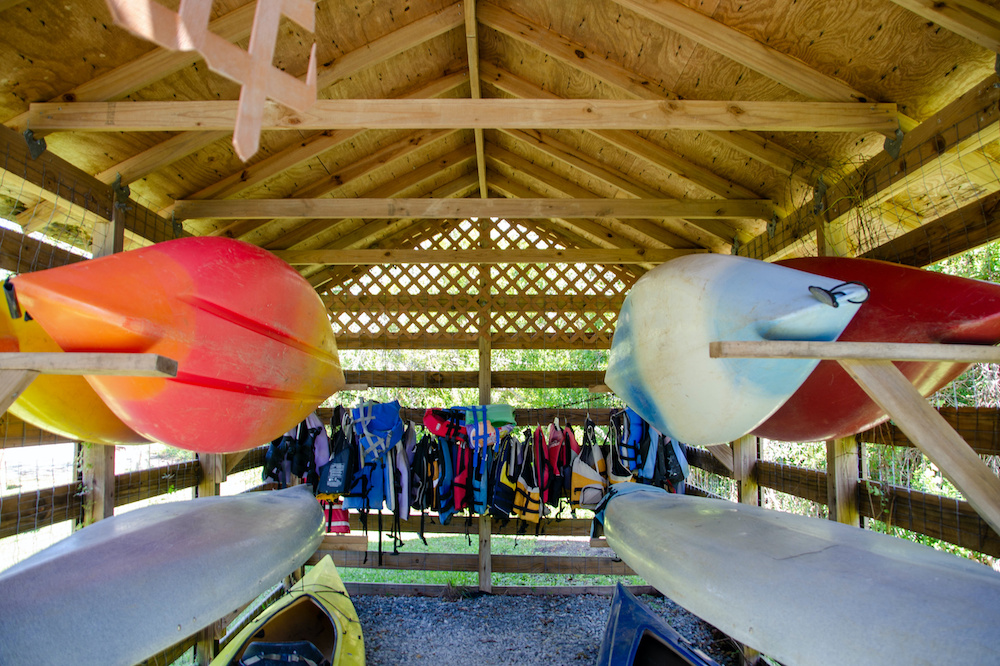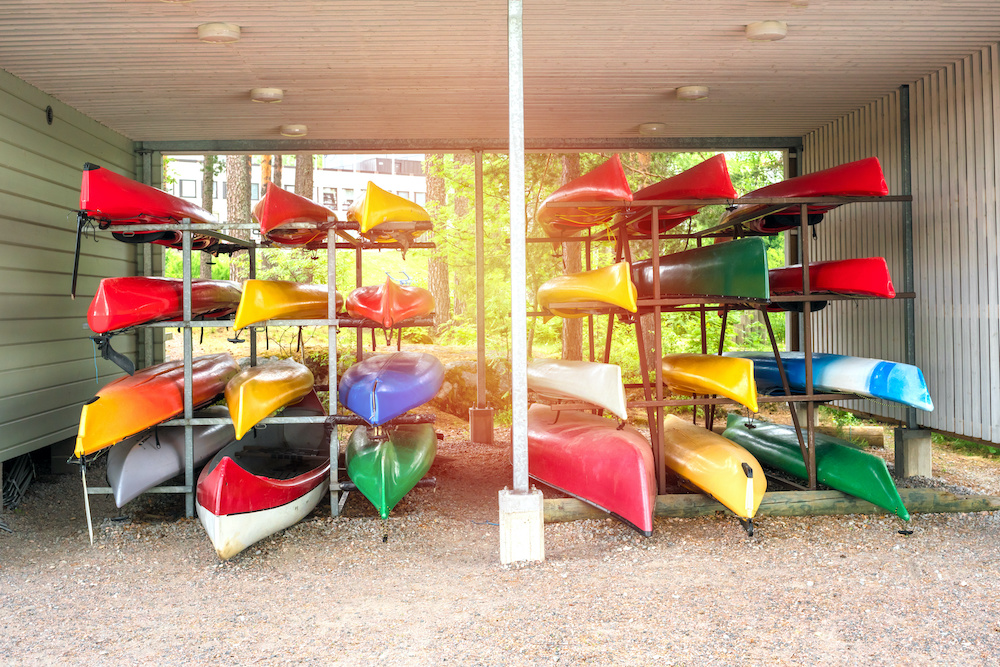How to Store a Kayak Properly
We may earn a commission for purchases using our links. As an Amazon Associate, we earn from qualifying purchases.
Just bought a new kayak? Part of caring for your investment is making sure you stored it properly.
It is essential to know how to store a kayak so you can use it to its full potential.
It also ensures that the vessel doesn’t get damaged and gives you plenty of usable years.
Today, we’ll go over the ways to store your kayak correctly.
We’ll also answer some storage-related questions that can help you care for your vessel better.
How Should You Store a Kayak?
With their big and bulky frames, kayaks can be a little tricky to store.
Of course, this shouldn’t discourage you from doing proper kayak storage.
It should include finding the ideal place to store your kayak and knowing exactly how to store kayaks to prevent damage and theft.
First, we’ll look at where you should be storing a kayak.
Where to Store a Kayak
The type of kayak you own also determines how easy or difficult it is to store them.
For instance, with a folding or inflatable kayak, storage shouldn’t be that hard.
Storing a kayak classified into either of these types might just involve loosely rolling or folding the vessel and stashing it inside a duffle bag.
Then, you can place the bag somewhere cool and dry, and you’d be all done.
The trouble with kayak storage usually comes when you have to do it with a traditional kayak.
These kayaks have hard shells, but their size and structure can make it difficult for you to find the right spot to store them in.
Factors to Consider
If you’re thinking of a place for storing your boat, make sure to consider the following factors.
- Moisture
Knowing how to store kayaks means making sure you don't stash them in an area where they could get exposed to moisture.
Moisture from snow or rain can cause the materials making up the boat to deteriorate over time.
- Sunlight
UV rays from the sun can degrade almost any material directly exposed to it.
The kayak hull could be made of high-quality fiberglass or plain plastic.
It’ll meet the same fate, either way.
For that reason, you want to store your kayak away from areas that get hit by direct sunlight.
- Cold
Cold isn’t as damaging to kayak materials as heat is, but it is still a cause for concern.
That’s because the repeated freezing and thawing of your boat is bound to cause some damage eventually.
You especially want to keep this in mind when you own a fiberglass vessel.
That's because this particular material doesn’t take too well when exposed to moisture repeatedly.
- Heat
This element poses the most danger to your vessel.
If your storage room gets too hot, or if you’re storing your kayak near a heat source, you could risk deforming the materials that compose its hull.
So, make sure areas that get hit by direct sunlight or are near sources of heat are off-limits to your precious kayaks.
Options
Given the factors, where then should you store your kayaks?
You’ve got two choices: outdoors or indoors.
- Outdoor
You’ve probably wondered if storing kayak outside is a good decision. It is but under the right conditions.
That means you must have a shaded outdoor spot to protect your kayak from sunlight and moisture.
In the absence of a shaded area, you should suspend a weather-resistant tarp above the vessel.
It should keep the elements from making a negative impact on your kayak.
Your spot also mustn’t be where moisture can collect on your boat.
In case you’re suspending a tarp above your boat, make sure it’s done in a way that won’t cause the tarp to fill up with water and press down on the hull.
This could potentially deform your boat and make it unattractive.
That said, kayak storage outside usually isn’t an option for homeowners pressed for space, such as those living in tiny apartments and condo units.
- Indoor
In debates concerning kayak storage outside vs. inside, the latter usually wins.
That’s because we’d rather keep our precious investments where they get better protection.
That could be in your garage, in a shed, or inside your house.
Nevertheless, you might not have enough indoor space to accommodate a large, bulky vessel.
Is It OK to Store a Kayak Vertically?
While you can store your kayak on one end vertically, you mustn’t do this for longer than a day.
That’s because a kayak laying on one side for long periods could deform the hull.
That is especially true with vertical storage since it causes the kayak’s weight to put pressure on the boat, distorting the section resting on the floor or other surfaces.

How Do You Store a Kayak in the Garage?
If you’re storing your kayak in the garage, which we’ve established is a great idea, you can do it in any of the following ways:
Use Wall-Mounted Racks
If you have enough wall space in your garage, this should be a great option.
This system is ideal for storing multiple kayaks, which could potentially rob you of a lot of ground space.
Just keep in mind that all of your racks have to be secured to the wall firmly, particularly the ones at the topmost positions.
Imagine the damage the kayak closest to the ceiling could inflict on the others at the bottom if it fell.
Overhead Suspension
Yes, this applies to the indoor setting, as well.
With an overhead suspension system, you can store kayaks using space that otherwise wouldn’t be occupied in your garage.
Still, you must note that these systems are complicated, so you must buy one and have it installed by professionals.
Upright Storage
Storing your kayaks upright is a great way to save on space.
After all, a vessel positioned upright doesn’t occupy nearly as much space as one stored length-wise.
Just make sure to vary the positioning regularly so as not to deform the hull.
How to Store a Kayak to Prevent Damage
Whether you’re storing kayak outside or inside, don’t place your boat directly on the ground.
That’s because when these vessels make contact with the floor for long periods, they could potentially deform the hulls.
Also, remember that the ground contains dirt and moisture that could potentially be as damaging to the boat as the pressure it receives from the floor.
The suspension system is what most paddlers would recommend for storing kayaks outside or inside.
The method usually involves the following:
Use a Rack
You can either buy one or learn how to make your own kayak rack. While this structure allows you to keep your boat from coming in contact with the ground, make sure to position the vessel with the hull-side up to prevent from damaging that area.
Consider a Suspension
This system should get your boat away from the ground.
It makes use of webbing straps that don’t damage the kayak hull in any way.
Still, to ensure that the hull remains untouched throughout the storage duration, make sure to hang the boat so that the hull faces the ceiling.
The grab loops should never be an option to hang the boat by.
Doing this could bend the boat, which might ruin it completely.
Important Pointers
Some other important points to ponder on when figuring out how to store a kayak outside or inside are:
- Cleaning
Whether you’re planning to store your kayak outside or inside, making sure it’s clean before doing so can save you a whole lot of trouble.
Remember that grime, dirt, or salt from whatever body of water you used your boat in can be potentially damaging.
Make sure to wash off these minerals with fresh water before stashing your boat away.
This method also applies to foldable or inflatable kayaks.
- Even Weight Distribution
When the kayak’s weight isn’t supported evenly, this could cause the hull to deform over time.
Use nylon straps or padded cradles to support the boat's opposite points, so there’s equal weight support on both sides.
Positioning these support items up to one-third of the way should be good enough to prevent the potential hull curving.
- Stay Away From Pressure Points
Whether you’re using a suspension or rack system, avoid strapping too tightly when transporting the vessel on your car.
Too much pressure on these sections of the kayak for long periods can cause the hull to bend.
It doesn’t matter if you’re trying to find out how to store a kayak outside or inside; these points are crucial to doing the job the right way.
Is It OK to Leave Kayak Outside in Winter?
As mentioned previously, the repeated freezing and thawing of your boat’s materials can potentially be damaging.
As such, it’s not recommended you store your kayak outside during winter.
However, if outside storage has been your method of choice for kayaks ever since, you want to adapt a system that prevents your boat from collecting snow and moisture.
Storing Your Kayak Is Easy and Rewarding
Once you’ve figured out the storage method that works best for your kayak, you should have no problem using the vessel to its full potential.
When you know how to store a kayak properly, it won’t matter if you stash it indoors or outdoors; you would still get the same great results.

